Multimedia Special Seminar
Tepia Hall - Tokyo, Japan
Keynote Speech, February 12, 1997
The Artist, Academia, and Industry
I am very pleased to be here with you at this
very exciting time. I would like to thank the Ministry of International
Trade and Industry, the Tokyo Metropolitan Government, the Multi-Media Content
Association of Japan, and All Nippon Airways.
The world is changing, and we are the leaders and pioneers. As contemporary
artists working with technology, we find ourselves at the intersection of
the arts and sciences, in academia, and in industry, as we explore and prototype
new media and their uses. Our work takes place in private studios, in high-tech
classrooms, and in research laboratories, sometimes all at the same time.
Our role in the development and application of new technology is increasingly
being recognized, formalized and supported through grants, artists residencies,
artist research positions, and new positions emerging from these new fields.
Multimedia technology is a reflection of the interdisciplinary activity
pioneered by artists throughout this Century. Continuing at the forefront
of this expanding terrain, we are at the center of the new global communication
and information explosion.
Art is cultural artifact, the integration of content and media. Contemporary
multi-media is digital, and integrates those media traditionally considered
separate, especially graphics, sound, and text. Because of their common
digital foundation, data in one modality can be fluidly transformed into
another, creating a rich, unified multisensory experience that goes beyond
simple combination. This experience can be engaged interactively in real-time,
much the way a musician performs a musical instrument. These new cultural
forms can be experienced instantaneously and simultaneously from great distances
around the globe, through the use of digital telecommunications.
Because we have linked our computers to telescopes, satellites, and microscopes,
we can listen to sounds from beyond the solar system, and see images as
small as a molecule, or as broad as a planet. We can see for ourselves the
extent to which the ozone layer is being depleted, and watch as our precious
rain forests and wetlands increasingly vanish. We are literally linked to
each other and to the earth, and can see our planet as one rather than as
separate countries. We have a dynamic, global self portrait on-line every
day. Through the Internet all data is part of a dynamic digital continuum,
and we can engage it as active participants. In the process, we can not
only develop and refine our content and technology, but develop new kinds
of relationships with people from afar and become more conscious of the
world around us and our role in it.
If technology is to enhance the quality of life, artists must contribute
significantly to its development. Imagine if language was invented without
the involvement of spiritual leaders, poets, or philosophers. No Aristotle,
Basho, Shakespeare, or any of the other great individuals who contributed
to the evolution of our languages and cultures. Language would be as simple
as the words on street signs, and as ungraceful as the code of computer
programs. Now that sound and moving images are as essential to carrying
cultural messages as are written words, the artist is just as important
as the poet and philosopher in shaping the future of language and culture.
Academia is one place where artists have been able to pursue their work,
where new talent is nurtured and ideas are transferred between fields. It
is also where knowledge about art, science and the humanities is disseminated
to the public. Some artists have also found support for their work in industry.
The entertainment industry has employed numerous graphic artists, writers,
actors and musicians in the creation of feature films and television, and
have invested in technology which enhances the realism of special effects
and lowers the cost of production. Communications and technology companies
in particular have supported the development of new media such as computer
graphics and digital music, through the direct involvement of cutting edge,
creative artists. They, along with science and engineering departments in
universities have for many years been places where important research and
development has taken place for the benefit of all. Increasingly, film and
media art schools are involved with this kind of research, especially as
the defense industry in the United States has faded as the primary supporter
of technological research.
In the most open minded, and often most accomplished research centers, artists
are sought by engineers and scientists for their farsightedness and creativity,
and for their ability to see relationships and recognize potentialities
in ways that complement scientific methods. While important differences
continue to exist between the artists and scientists, they often share common
vocabularies, working methodologies, values and goals. This allows for unusual
bridges to be built and creative synergetic interaction to take place. The
distinction between them is becoming more and more blurred and new models
of collaboration are becoming more and more common.
Artists are visionaries, windows to the future, inventors, innovators and
people who make great conceptual leaps. They are thinkers and creators who
continually extend perception, thought and expression, people who challenge
their abilities, push the limits of their instruments, and adapt them to
new purposes. They are synthesizers and synergizers of new information,
people who see relationships between seemingly unrelated things and build
bridges where none existed before. They are mirrors of the culture, signposts,
people who perceive unspoken truths and report on them. They solve complex
problems barely recognized by others and offer their solutions to the public,
benefiting the broader culture as it catches up. In a global visual communication
culture, artists are the translators and inventors. They are researchers
in communication and in the representation of complex information.
Artists share a common creative spirit with scientists. Many scientists
have deep respect for the arts and also share the common aspiration of originality,
quality and esthetic refinement of their work. In fact, in the United States
many scientists have art backgrounds; write poetry, play musical instruments
or paint. They incorporate creative thinking processes into their scientific
work. Conversely, many artists employ the scientific method in their work,
hypothesizing, experimenting and revising experiments in a cyclical process
of discovery. The relationship that artists have with their means of expression
- whether paint and brush or violin and bow, is part of the interest that
scientists have in collaborating with artists - to make tools for scientists
and the public that are as fluidly sensitive to expression as traditional
artistic media.
Some leading companies have employed scientists, not to work on specific
products, but to do research in the pure sciences as they do in universities.
These companies realize that significant profit can be derived from the
practical realization of some of the resulting discoveries. Over the past
30 years, some companies have included artists as researchers as well, allowing
the same kind of freedom to pursue individual vision, with the same faith
that useful results will evolve, even when not explicitly mandated as a
condition of employment.
There are many examples of this. In the 1960's at Bell Laboratories, computer
scientist Ken Knowlton worked with artists Lillian Schwartz and Stan Vanderbeek
on early computer animation, and scientist Max Matthews worked with many
composers in creating the field of digital audio and computer music. At
Xerox, and later at Apple Computer, conceptual artists worked with cognitive
scientists and computer engineers to invent the now ubiquitous graphical
user interface, and new computer applications such as desk top publishing.
Important early work in computer graphics was done by Information International
Incorporated in the early 1980's. This company hired both artists and scientists,
and many of the artists did just as much programming as did the engineers.
Both the artists and scientists were driven by a passion to realize what
was never seen before, and worked together as equals, achieving their goals
and in the process accelerating the development of the technology.
Today, successful models such as these have been transformed into new industrial
and educational paradigms. Examples include companies such as Pacific Data Images,
where 25% of an artist's time is expected to be used in the creation of personal
artwork. It is felt that this pushes the development of the company's software,
and encourages originality in the work for clients. Silicon Graphics offers artist
residencies. Microsoft has hired some of the most famous computer graphics pioneers
in its graphics research group, and has also hired animators from USC to collaborate
with them. Princeton University initiated a computer science, visual art and music
curriculum designed to provide scientists and engineers with a humanistic and
artistic context for their discipline. The University of Illinois at Urbana Champaign
pioneered "Renaissance Teams" of artists and scientists in their prestigious
Scientific Visualization Center. USC has encouraged cross disciplinary undergraduate
and graduate programs which fuse art and technology, especially in our School
of Cinema-Television and in the Annenberg Center. The latter provides grants to
encourage interdisciplinary collaborations. One such grant is currently supporting
my work with chemist Dr. Mark Thompson on the development of new display technology
for computer art. Intel Corporation supports outside research, including a collaborative
project between myself, composer Rand
Steiger and computer scientist Miller Puckette (author of the MAX programming
language) for an Internet project called "The Global Visual Music Jam Session."
I have worked closely with computer scientists at California Institute of
Technology, Princeton University, the San Diego Supercomputer Center, and
at USC. I have consulted on many aspects of computer graphics development,
and in turn, I have worked with the tools I helped develop in realizing
many of my artworks. I would like to share some of them with you now:
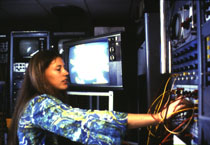
This is a picture of me working with analog computer animation equipment
in the mid 1970's when I was an artist-in-residence at Rensselaer Polytechnic
Institute. I helped to develop processes that integrate electronic music
and early computer animation and video special effects equipment. A real-time
system, it applied the patch programmable paradigm of electronic musical
instruments to video and computer devices, and allowed for a common signal
to control both systems. I made many works with this system. Many of my
students from RPI are now professionals in academia and the entertainment
industry.
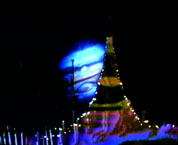
In the 1980's I collaborated with an RPI graduate Dean Winkler and filmmaker
Tom DeWitt on the production of a series of video artworks. In "Voyage",
we attempted to visualize a flight into our minds and outwards to space.
We combined images of Jupiter from the Voyager spacecraft, video images
of nature, as well as electronic signals from a spectrum analyzer, combined
with digital animation devices.
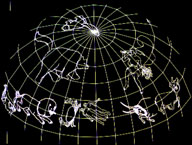
In 1983, I worked on the first computer animated omnimax film called the
Magic Egg. I created the "Constellation Sequence" which made use
of the NASA star data base and special software written in collaboration
with computer scientist James Blinn at the Jet Propulsion Laboratory. It
represents the transition from an anthropomorphic and anthropocentric model
of the universe to our current model. The sphere has constellations animating
on it, and it enters the field of view from above and comes down in front
of the audience. Then it comes closer to the audience which penetrates its
surface and gradually moves into the center of it. Just as the surface of
the sphere coincides with the dome of the planetarium, the constellations
fade out and just the stars remain and are seen at infinity.
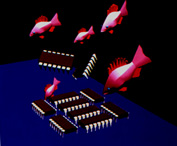
In 1985, I was appointed Artist-in-Residence at the California Institute
of Technology Computer Science Department. I worked closely with researchers
there to develop three dimensional modeling, animation and rendering software
for use by artists and scientists. I created a series of works which explore
the convergence of perception, language and technology. All are stereoscopic,
including this one, "Fish and Chips." The fish represent art and
the chips, technology.
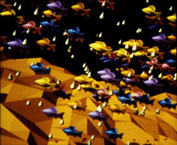
This one is called "Microfishe."
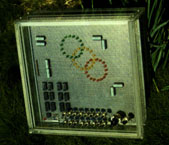
In 1986, I created the "Three Ring Circuit" which is a small sculpture
which I designed and built while I was attending a class taught by the physicist
Richard Feynmann at Caltech. It is interactive and the user can adjust numerous
parameters in the animation of LED's. I consider electronic circuit design
an important part of the artist's tool kit, and something that should be
included in their education.
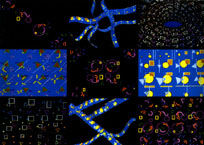
In 1986, I created NLOOPS, which is modeled after cyclical musical processes
combined with references to the Zoetrope, the earliest animation device
which was used to look at cycles of animation. I extended the zoetrope into
another dimension on the computer, making a torus or donut. I wrote special
software to animate the frames so that there are loops running vertically
and horizontally on the surface of the donut -
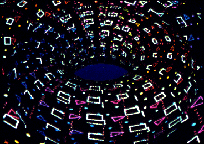
with exactly the same number of frames as there
are segments. The result is of waves of animation cycles flowing around
its surfaces. It was developed into a 3-videotape, 9 monitor installation
-
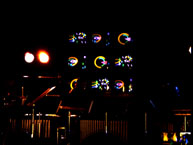
-where live percussion music performance was to affect the distribution
and other elements of the animation. I showed this piece to students in
computer science at Princeton University who became very excited. One man
thanked me for giving him the idea of using 3-D solids with surfaces that
animate to visualize multidimensional mathematics. Here now is three minutes
of N Loops, a 7 minute computer animated work, with music by Rand Steiger.
[VIDEO 1 NLoops]
In 1989, I received a National Science Foundation
grant in collaboration with Molecular biologist Lynn Teneyck and computer
scientist Phil Mercurio for the development of the Interactive Stereoscopic
Animation System at the San Diego Supercomputer Center. Our collaborative
premise was that artists require the most supple and expressive tools, and
scientists working with visualization technologies could benefit from the
perceptual demands that artists make on these tools.
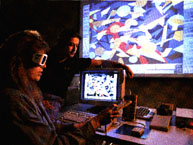
We created a virtual reality system, a kind of real-time immersive data-microscope
for use by groups of scientists who were exploring dynamic molecular models
in real-time. It has been used by a great many people, including scientists,
artists, and architects. My test of the system was the creation of the stereoscopic
piece "Maya", the title refers to the Hindu concept of the conflict
between illusion and reality.
Here now is a three minute segment of "Maya" an 8 minute work.
Again my musical collaborator was Rand Steiger. Maya is a stereoscopic work.
When shown in its entirety at film festivals it requires quadraphonic sound,
dual projectors, and 3D glasses for the viewers to have the full spatial
experience. You can still get a good sense of the piece from this 2D version.
[VIDEO 2]
As I discussed in my introductory remarks, I believe that we are all developing
a collective memory and collective consciousness through our distributed,
on-line computing networks, and we are not only a product of our individual
experiences, but of our collective experiences as we connect to nature and
other cultures around the world. To explore this further, I am now working
on a stereoscopic animation project called "Earth Consciousness"
-
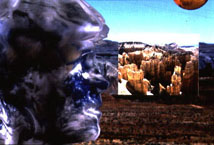
which explores our awareness of our environment. This piece involves the
creation of new software for stereoscopic rotoscope of video and film, which
I am developing in collaboration with the Dept. of Neuroscience at the University
of California, San Diego. The project is supported by a grant from the James
H. Zumberge Faculty Research and Innovation Fund at the University of Southern
California.
I have been interested in how memory works,
and have been using non-linear processes to explore my own memory-
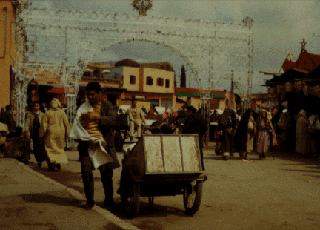
of an influential trip to Morocco in 1971. I scanned into the computer pages
from my journals -
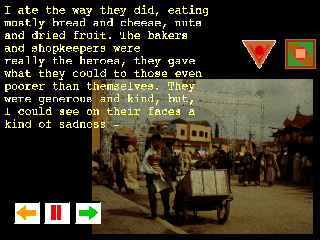
and photographs from that time, and I am comparing the actual documentation
with my recent reflections on that period of my life.
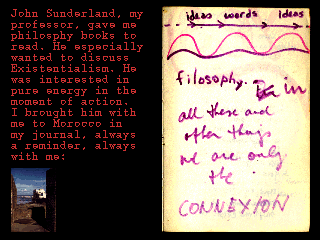
The images and texts link in complex ways, and after constructing the links-
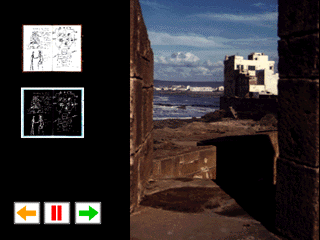
I discovered that a model that emerged was like a conch shell, where the
current memory links to older and more recent memories in a constantly shifting,
dynamic model of memory.
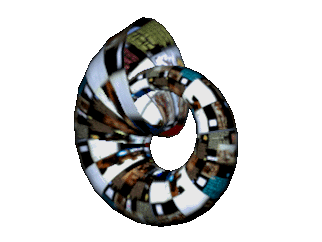
This past summer, I participated in a 3 -week seminar
hosted by the MindShip Foundation in Copenhagen, with 30 artists and scientists who
were brought together to share ideas and knowledge on the theme of "Order,
Complexity, and Beauty." This included biologists, mathematicians, physicists,
visual artists and composers. I collaborated with composer K@rlheinz Essl on an installation piece in which text statements written by
the seminar participants were deconstructed and reconstructed using computer
algorithms, and juxtaposed with computer animation and graphics from my own
work and that of the other participants, as well as "found" art from
the world wide web, including images of historically significant mathematicians
and philosophers.
Initially this was presented as a 4 computer installation, with the reconstructed
texts printed on the screens and read by whispering computer generated voices.
The texts and images were recombined using random algorithms to create an ever
changing sequence of statements. This has become a perpetual piece, available
now as a web site. The relationships between the elements keep changing as each
page is computed using random algorithms before it is displayed, including links
to other randomly chosen web sites, anagram programs, and automatically prompted
email responses from the observer. It is a visual and textual manifestation
of the complexity theory that was explored during the seminar. It is also a
collective consciousness of the participants of the MindShip experience, hence
a "MindShipMind".
Finally, I have created a short animation for a celebration of experimental
animation, curated by artist-animator Christine Panushka, and sponsored by Absolut
Incorporated on their web site, Absolut
Panushka. I created a stereoscopic movie (quicktime and shockwave) that will be premiered on-line at
their site next Monday, February 17.
Should you wish to explore these works further, there are examples of all of
this work, and links to the various web sites I mentioned on my web site
at U.S.C.
I have been involved in education for almost two decades, and my research
and creative work has always informed my teaching. After 10 years as director
of the Computer Animation Lab at California Institute of the Arts, I moved
to the University of Southern California in 1994. The School of Cinema Television
at The University of Southern California was established in 1929 as a collaboration
between the University and the Academy of Motion Picture Arts and Sciences
and was the first University to offer degrees in these fields. It has had
an unparalleled impact, with many of our graduates going on to leading positions
in the arts, and in the entertainment and communication industries, including
the visionary director and producer George Lucas. I am Chair of the Division of Animation and Digital Arts in the School of Cinema Television. We offer our students
a wide range of courses including writing, criticism, film and video production,
hand drawn and computer animation, and the newest interactive technologies.
We encourage our students to pursue their own individual creative vision
in the creation of work in a wide range of genres and media.
I would like to offer you now one example, an excerpt from an interactive
CD Rom by a graduate student named Kristy Kang, who was here in Japan last
summer working as an intern with Noriko Mukai at TBS. Her piece deals with
identity as a product of three kinds of memory. The Mind explores the mythological
and intellectual, The Heart explores the emotional, and The Body explores
the physical. Here is the first section.
[CDROM]
I have offered this and my own experiences to you today as an example of
the many artists around the world who have been exploring new forms in collaboration
with scientists. I offer this example to you to encourage the breaking down
of barriers between disciplines, and the evolution of a new spirit of cooperation
and collaboration among artists, scientists, and engineers.
Just as new fields arise from the synthesis of seemingly unrelated fields,
new and profound ideas can arise from the synthesis of seemingly unrelated
concepts. For multi-media to reach its true potential, we must challenge
ourselves to go beyond the now conventional paradigms of web pages and CD
Roms, to take a broader view. Multi-media is about interaction and synergy,
and the new possibilities that exist, catalyzed by dynamic electronic technology
as an extension of the human mind and body. It is about a renaissance in
art and science and new bridges being built in academia and industry to
reconnect once closely related fields that became separated by over specialization
in what was originally a quest for universal knowledge.
It is about empowering the individual as an active participant in decentralized,
ubiquitous, multi-modal expression and communication media. And providing
entry for the voices and visions of people traditionally excluded from mass
media.
It is about a multitude of multiplicities; multiple modes, disciplines and
cultures. It is about promoting respect and tolerance for unfamiliar ideas
and information. It is about becoming whole, as a person and as a world.
Vibeke Sorensen
February 8, 1997
Go to 
Go to 
Go to 
Go to 















